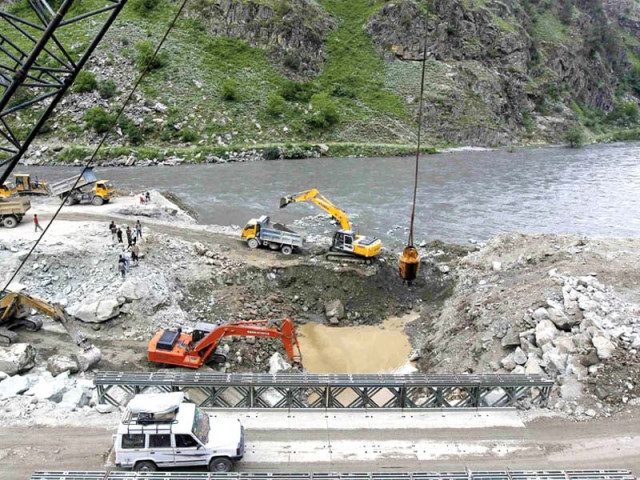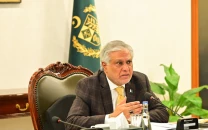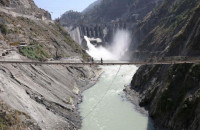Thirsty S Asia’s river rifts threaten ‘water wars’
Islamabad concerned about water flow being affected by Indian dams.

As the silver waters of the Kishanganga rush through the north Kashmir valley, Indian labourers are hard at work on a hydropower project that will dam the river just before it flows across one of the world’s most heavily militarised borders into Pakistan.
The hum of excavators echoes through the pine-covered valley, clearing masses of soil and boulders, while army trucks crawl through the steep Himalayan mountain passes.
The 330-MW dam is a symbol of India’s growing focus on hydropower but also highlights how water is a growing source of tension with downstream Pakistan, which depends on the snow-fed Himalayan rivers for everything from drinking water to agriculture.
Islamabad has complained to an international court that the dam in the Gurez valley, one of dozens planned by India, will affect river flows and is illegal. The court has halted any permanent work on the river for the moment, although India can still continue tunnelling and other associated projects.
In the years since their partition from British India, land disputes have led the two nuclear-armed neighbours to two of their three wars. Water could well be the next flashpoint.
“There is definitely potential for conflict based on water, particularly if we are looking to the year 2050, when there could be considerable water scarcity in India and Pakistan,” says Michael Kugelman, South Asia Associate at the Woodrow Wilson International Center for Scholars in Washington.
“Populations will continue to grow. There will be more pressure on supply. Factor in climate change and faster glacial melt ... That means much more will be at stake. So you could have a perfect storm which conceivably could be some sort of trigger.”
It’s not just South Asia – water disputes are a global phenomenon, sparked by growing populations, rapid urbanisation, increased irrigation and a rising demand for alternative power such as hydroelectricity.
Turkey, Syria, Iran and Iraq quarrel over the waters of the Tigris and Euphrates. The Jordan River divides Israel, Jordan, Lebanon and the West Bank. Ten African countries begrudgingly share the Nile.
In Southeast Asia, China and Laos are building dams over the mighty Mekong, raising tensions with downstream nations.
A US intelligence report in February warned fresh water supplies are unlikely to keep up with global demand by 2040, increasing political instability, hobbling economic growth and endangering world food markets. A “water war” is unlikely in the next decade, it said, but beyond that rising demand and scarcities due to climate change and poor management will increase the risk of conflict.
That threat is possibly nowhere more apparent than in South Asia, home to a fifth of humanity and rife with historical tensions, mistrust and regional rivalries.
The region’s three major river systems – the Indus, the Ganges and the Brahmaputra – sustain India and Pakistan’s breadbasket states and many of their major cities including New Delhi and Islamabad, as well as Bangladesh.
“South Asia is symbolic of what we are seeing in terms of water stress and tensions across the world,” says BG Verghese, author and analyst at New Delhi’s Centre for Policy Research.
The region is one of the world’s most water-stressed, yet the population is adding an extra 25 million people a year – South Asia’s per capita water availability has dropped by 70% since 1950, says the Asian Development Bank.
Published in The Express Tribune, July 24th, 2012.



















COMMENTS
Comments are moderated and generally will be posted if they are on-topic and not abusive.
For more information, please see our Comments FAQ